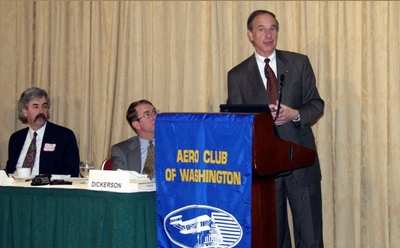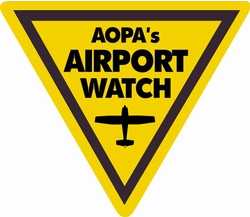AOPA Members Are Overwhelmingly Optimistic About GA's
Future
 AOPA President Phil Boyer told an audience of
Washington, D.C. insiders that at least one sector of the aviation
industry has a bright future. Borrowing a phrase from aviation
meteorologists, Boyer said the future for general aviation is CAVU
— ceiling and visibility unlimited. In a presentation to the
Aero Club of Washington, which boasts some of the biggest names in
aviation, Boyer said that everything from single-engine piston
sales to avionics installations to new student pilots indicate an
industry that is still moving ahead in spite of a generally sour
economy.
AOPA President Phil Boyer told an audience of
Washington, D.C. insiders that at least one sector of the aviation
industry has a bright future. Borrowing a phrase from aviation
meteorologists, Boyer said the future for general aviation is CAVU
— ceiling and visibility unlimited. In a presentation to the
Aero Club of Washington, which boasts some of the biggest names in
aviation, Boyer said that everything from single-engine piston
sales to avionics installations to new student pilots indicate an
industry that is still moving ahead in spite of a generally sour
economy.
One of the best indications of where GA is headed is the general
attitude of its pilots. AOPA asked its members in a survey this
year, "Are you optimistic or pessimistic about the future of
GA?"
"Even in these times of uncertainty and heightened security
restrictions, a full two thirds of our members said they're
optimistic," Boyer reported. He noted that while GA runs the gamut,
from Piper Cub to 747, AOPA's typical member flies a piston-powered
single-engine aircraft with fixed gear and four seats.
"In the business I'm in," Boyer told his audience, "an
association's membership number is its business barometer. It also
indicates the health of the marketplace you serve. At the end of
April 2003, AOPA had 396,754 members. We're well on our way to
400,000." AOPA's membership has grown by 30,000 in the year and a
half since the September 11 terrorist attacks. That growth alone
speaks to the enthusiasm of GA pilots.

Another key indicator of the GA sector's overall health is the
total number of pilot certificates held and, more importantly, the
number of new student pilot certificate issuances. While not
spectacular, both numbers showed healthy increases from 2001 to
2002. And a key to getting new pilots into the system has been the
Be A Pilot program, which offers $49 introductory flights through
flight schools throughout the country.
 Boyer
also noted that shipments of single-engine piston aircraft are up
some 6% in the first quarter of 2003 compared to a year ago. That
increase kept an overall decline, primarily among turbine-powered
models, from being even steeper. In addition, the number of FAA
aircraft registrations through April 2003 is running several
hundred ahead of the same time period last year.
Boyer
also noted that shipments of single-engine piston aircraft are up
some 6% in the first quarter of 2003 compared to a year ago. That
increase kept an overall decline, primarily among turbine-powered
models, from being even steeper. In addition, the number of FAA
aircraft registrations through April 2003 is running several
hundred ahead of the same time period last year.
Airframe manufacturers are not the only ones benefiting from
GA's bright future. Boyer said avionics manufacturers are helping
drive the boom. With an aging GA fleet and the relatively high cost
of new aircraft, pilots are opting instead to upgrade their panels
with the latest advancements in avionics. Boyer told the audience
that one of the greatest challenges — and greatest
opportunities — facing general aviation is the widespread
misconceptions among government (and especially security) officials
and the general public.
 He highlighted three programs to combat the
misunderstandings. AOPA's Airport Watch is designed not only to
help keep GA airports secure, but to show security officials that
GA is capable of policing itself. To help the general public
understand what GA is and how they benefit whether they're pilots
or not, AOPA created the GA Serving America Web site and advertised
it heavily in both major daily newspapers and on television.
He highlighted three programs to combat the
misunderstandings. AOPA's Airport Watch is designed not only to
help keep GA airports secure, but to show security officials that
GA is capable of policing itself. To help the general public
understand what GA is and how they benefit whether they're pilots
or not, AOPA created the GA Serving America Web site and advertised
it heavily in both major daily newspapers and on television.
Finally, to help protect GA airports and keep any disagreements
between the community and an airport from being overblown, AOPA
maintains the Airport Support Network. "This all-volunteer corps
acts as the eyes and ears of AOPA at hundreds of public-use
airports across the country," Boyer said. "Our goal is to have a
volunteer at all 5,400 public-use airports. We already have over
1,400."
"We've got our problems," Boyer noted in conclusion, "but key
indicators show that the main uses of a personal airplane —
for work, for three-day weekends, for vacations — are alive
and well. Ours is an industry showing signs of being a flight into
CAVU."
 ANN's Daily Aero-Term (06.03.25): No Gyro Approach
ANN's Daily Aero-Term (06.03.25): No Gyro Approach ANN's Daily Aero-Linx (06.03.25)
ANN's Daily Aero-Linx (06.03.25) ANN FAQ: Turn On Post Notifications
ANN FAQ: Turn On Post Notifications Airborne 05.30.25: Anti-Helicopter Bill, PW Strike Done, All-Electric Bristell
Airborne 05.30.25: Anti-Helicopter Bill, PW Strike Done, All-Electric Bristell Airborne 05.29.25: ATC Bonu$, VX4 eVTOL Flies, Starship 9 Test
Airborne 05.29.25: ATC Bonu$, VX4 eVTOL Flies, Starship 9 Test






